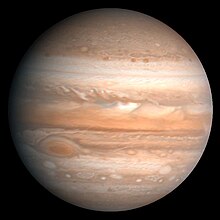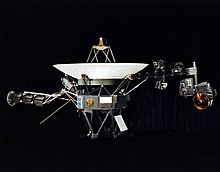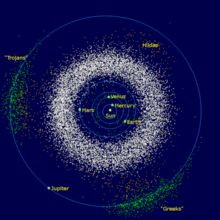Jupiter
Jupiter is the largest planet in the Solar System. It is the fifth planet from the Sun.[17] Jupiter is a gas giant because it is so large, and made mostly of gas.[18] The other gas giants in the Solar System are Saturn, Uranus, and Neptune.
 Full-disc view in natural color in April 2014[a] | |||||||||||||
| Designations | |||||||||||||
|---|---|---|---|---|---|---|---|---|---|---|---|---|---|
| Pronunciation | /ˈdʒuːpɪtər/ ( | ||||||||||||
Named after | Jupiter | ||||||||||||
| Adjectives | Jovian /ˈdʒoʊviən/ | ||||||||||||
| Orbital characteristics | |||||||||||||
| Epoch J2000 | |||||||||||||
| Aphelion | 816.62 Gm (5.4588 AU) | ||||||||||||
| Perihelion | 740.52 Gm (4.9501 AU) | ||||||||||||
| 778.57 Gm (5.2044 AU) | |||||||||||||
| Eccentricity | 0.0489 | ||||||||||||
| |||||||||||||
| 398.88 d | |||||||||||||
Average orbital speed | 13.07 km/s (8.12 mi/s) | ||||||||||||
| 20.020°[3] | |||||||||||||
| Inclination |
| ||||||||||||
| 100.464° | |||||||||||||
| 21 January 2023[5] | |||||||||||||
| 273.867°[3] | |||||||||||||
| Known satellites | 95 (as of 2023[update])[6] | ||||||||||||
| Physical characteristics[13][page needed][14] | |||||||||||||
Mean radius | 69,911 km (43,441 mi)[b] 10.973 Earths | ||||||||||||
Equatorial radius |
| ||||||||||||
Polar radius |
| ||||||||||||
| Flattening | 0.06487 | ||||||||||||
| |||||||||||||
| Volume |
| ||||||||||||
| Mass |
| ||||||||||||
Mean density | 1,326 kg/m3 (2,235 lb/cu yd)[c] | ||||||||||||
| 24.79 m/s2 (81.3 ft/s2)[b] 2.528 g | |||||||||||||
| 0.2756±0.0006[8] | |||||||||||||
| 59.5 km/s (37.0 mi/s)[b] | |||||||||||||
| 9.9258 h (9 h 55 m 33 s)[2] | |||||||||||||
Sidereal rotation period | 9.925 hours[9] (9 h 55 m 30 s) | ||||||||||||
Equatorial rotation velocity | 12.6 km/s (7.8 mi/s; 45,000 km/h) | ||||||||||||
| 3.13° (to orbit) | |||||||||||||
North pole right ascension | 268.057°; 17h 52m 14s | ||||||||||||
North pole declination | 64.495° | ||||||||||||
| Albedo | 0.503 (Bond)[10] 0.538 (geometric)[11][page needed] | ||||||||||||
| |||||||||||||
| −2.94[12][page needed] to −1.66[12][page needed] | |||||||||||||
| 29.8" to 50.1" | |||||||||||||
| Atmosphere[15] | |||||||||||||
Surface pressure | 200–600 kPa (opaque cloud deck)[16] | ||||||||||||
| 27 km (17 mi) | |||||||||||||
| Composition by volume | |||||||||||||


Jupiter was discovered by Galileo Galilei in 1610 with a small telescope. The planet has a Great Red Spot which is located at 22 degrees south of Jupiter's equator, it produces wind-speeds up to 432 km/h (268 mph).
By mass, Jupiter's atmosphere is around 76% hydrogen and 24% helium, though because helium atoms are more massive than hydrogen molecules, Jupiter's upper atmosphere is about 90% hydrogen and 10% helium by volume. The atmosphere also contains trace amounts of methane, water vapor, ammonia, and silicon-based compounds as well as trace amounts of carbon, ethane, hydrogen sulfide, neon, oxygen, phosphine, and sulfur. The outermost layer of the atmosphere contains crystals of frozen ammonia. Through infrared and ultraviolet measurements, trace amounts of benzene and other hydrocarbons have also been found. The interior of Jupiter contains denser materials—by mass it is roughly 71% hydrogen, 24% helium, and 5% other elements.
Jupiter was the first planet to form, and its inward migration during the primordial Solar System impacted much of the formation history of the other planets. Jupiter is primarily composed of hydrogen (90% by volume), followed by helium, which makes up a quarter of its mass and a tenth of its volume. The ongoing contraction of Jupiter's interior generates more heat than the planet receives from the Sun. Its internal structure is believed to comprise an outer mantle of liquid metallic hydrogen, and a diffuse inner core of denser material. Because of its rapid rotation rate of 1 rotation per 10 hours, Jupiter's shape is an oblate spheroid: it has a slight but noticeable bulge around the equator. The outer atmosphere is divided into a series of latitudinal bands, with turbulence and storms along their interacting boundaries. The most obvious result of this is the Great Red Spot, a giant storm which has been observed since 1831 and possibly earlier.
Name and symbol

Jupiter was named for the king of the gods. The Greeks called him Zeus. The Romans called him Jupiter. The symbol for Jupiter, ♃, is from the Greek zeta. It has a horizontal stroke ⟨Ƶ⟩. This stands as an abbreviation for Zeus.[19][20][page needed][21]
Structure
Jupiter is the biggest planet in the Solar System. Its diameter is 142,984 km. This is eleven times larger than the diameter of Earth.[22] Jupiter is twice as massive as all the other planets in the Solar System put together.[23] Jupiter is 318 times as massive as Earth. The volume of Jupiter is 1,317 times the volume of Earth. In other words, 1,317 Earth-sized objects could fit inside it.[24] It gives off more heat than it gets from the Sun.[25][page needed]



Atmosphere
The atmosphere near the surface of Jupiter is about 90% hydrogen, 10% helium, and less than 1% other gases.[15]
The lower atmosphere is so heated and the pressure so high that helium changes to liquid. It rains down onto the planet.[26] Based on spectroscopy, Jupiter seems to be made of the same gases as Saturn. It is different from Neptune or Uranus. Those two planets have much less hydrogen and helium gas.[27]
Core
It is not possible to say exactly what metals are in the core of Jupiter.. However, by measuring the gravity around Jupiter, one can estimate its size. The inner core is dense. It has a lot of heavy elements, probably in the form of rock and ice. The heavy elements in the core have a total mass of 7–25 times that of Earth.[28]
Round the unknown inner core is an outer core. The outer core of Jupiter is thick, liquid hydrogen.[29]
Jupiter is mainly made of the same elements (hydrogen and helium) as the Sun, but it is not large enough to have the internal pressure and temperature necessary to cause hydrogen to fuse to helium, the energy source that powers the Sun and most other stars. If Jupiter had 75 times its mass, it could fuse hydrogen to helium.[30]
Cloud layers
Jupiter has many bands of clouds going horizontally across its surface. The light parts are zones and the darker ones are belts. The zones and belts often interact with each other. This causes huge storms. Wind speeds of 360 kilometres per hour (km/h) are common on Jupiter.[31] To show the difference, the strongest tropical storms on Earth are about 100 km/h.[32]
Most of the clouds on Jupiter are made of ammonia.[33] There may also be clouds of water vapor like clouds on Earth. Multiple spacecraft such as Voyager 1 have seen lightning on the surface of the planet. Scientists think it was water vapor because lightning needs water vapor.[34] These lightning bolts have been measured as up to 1,000 times as powerful as those on Earth.[34]
Great Red Spot
One of the biggest features in Jupiter's atmosphere is the Great Red Spot. It is a huge storm that is bigger than the entire Earth. It is on record since at least 1831,[35][page needed] and as early as 1665.[36][37] Images by the Hubble Space Telescope have shown as many as two smaller "red spots" next to the Great Red Spot.[38][39] Storms can last for hours or as long as hundreds of years in the case of the Great Red Spot.[40][41]
Magnetic field
Jupiter has a magnetic field like Earth's but 10 times stronger.[42] It also has a magnetosphere much bigger and stronger than Earth's. The field traps radiation belts much stronger than Earth's Van Allen radiation belts, strong enough to endanger any spacecraft travelling near. The magnetic field is probably caused by the large amounts of liquid metallic hydrogen in the core of Jupiter.[43] The four largest moons of Jupiter and many of the smaller ones orbit or go around the planet within the magnetic field. This protects them from the solar wind. Jupiter's magnetic field is so large, it reaches the orbit of Saturn 7.7 million miles (12 million km) away.[44] The Earth's magnetosphere does not even cover its moon, less than a quarter of a million miles (400,000 km) away. Jupiter also experiences large aurorae, which happen when charged particles from the volcanic moon Io land in its atmosphere.[45]
Ring system
Jupiter also has a thin planetary ring system.[46] These rings are difficult to see and were not discovered until 1979 by NASA's Voyager 1 probe.[47] There are four parts to Jupiter's rings. The closest ring to Jupiter is called the Halo Ring.[48] The next ring is called the Main Ring. It is about 6,440 km (4,002 mi) wide and only 30 km (19 mi) thick.[48] The Main and Halo rings of Jupiter are made of small, dark particles.[47] The third and fourth rings, called the Gossamer rings, are transparent and are made from microscopic debris and dust.[47] This dust probably comes from small meteors striking the surface of Jupiter's moons. The third ring is called the Amalthea Gossamer Ring, named after the moon Amalthea. The outer ring, the Thebe Gossamer Ring, is named after the moon Thebe. The outer edge of this ring is about 220,000 km (136,702 mi) from Jupiter.[48]
Formation
Jupiter and other gas giants probably started as rocky planets, similar to Earth. This theory is called the core accretion model.[49] The rocky core would have formed in the early Solar System, within a disk of gases around the Sun. When the planet reached a critical mass, its gravity started to quickly capture lots of gas. In this way, Jupiter became a giant planet. In order for Jupiter to reach this critical mass before the gas disk disappeared, there must have been lots of ice in the area. Jupiter must have formed outside the snow line, the area that is cold enough for water to freeze.[50][51]
The disk instability model is another theory. It says that Jupiter was formed by gas clumping together in the disk around the Sun. In this case, a rocky core would not need to form. However, this process would probably create planets that are bigger than Jupiter, so most scientists think Jupiter was formed by core accretion.[50][page needed]
Orbit
The orbit of a planet is the time and path it takes to go around the Sun. In the time it takes for Jupiter to orbit the Sun once, the Earth orbits the Sun 11.86 times.[52] One year on Jupiter is equal to 11.86 years on Earth.
The average distance between Jupiter and the Sun is 778 million kilometres. This is five times the distance between Earth and the Sun. Jupiter is not tilted on its axis as much as Earth or Mars. This causes it to have no seasons, for example summer or winter. Jupiter rotates, or spins around very quickly.[53] This causes the planet to bulge in the middle. Jupiter is the fastest spinning planet in the Solar System.[53] It completes one rotation or spin in 10 hours.[17] Because of the bulge, the length of the equator of Jupiter is longer than the length from pole to pole.[54]
Jupiter in the Solar System
Grand tack hypothesis
The orbit of Jupiter is unusual compared to planets in other star systems. It is usual for giant planets to be much nearer to their stars. Because Jupiter is not, this suggests an unusual explanation is needed for the arrangement of the planets in the Solar System. Astronomers have an idea on why this happened. It is called the grand tack hypothesis.[55][56][page needed][57]
It is suggested that Jupiter formed about 3.5 astronomical units from the Sun. It started migrating inward and scattered the rocky planet-forming materials out beyond its orbit.[58] Saturn formed later than Jupiter and started its own inward migration. When Jupiter reached 1.5 astronomical units, it became locked into an orbital resonance with Saturn.[59] Both planets turned around and moved outward until Jupiter arrived at its current position, 5.2 astronomical units from the Sun. Saturn arrived at about 7 astronomical units.[60]
The grand tack hypothesis explains another mystery of the Solar System. Mars should have been larger than Earth but is instead only 1⁄10 of this size. On Jupiter's grand tack, it cleared the area where Mars orbits today. After it left, the material remaining was only enough to form a small planet and a low-mass asteroid belt.[61][page needed][62][63] Although the hypothesis has not been absolutely proven, there is no other competing explanation why the Solar System's giant should be so far from its star, and Mars so small.
Asteroids and comets

Jupiter's large gravity has had an effect on the Solar System. Jupiter protects the inner planets from comets by pulling them towards itself. Because of this, Jupiter has the most comet impacts in the Solar System.[64] Jupiter has 95 known natural satellites.[65]
Two groups of asteroids, called Trojan asteroids, have settled into Jupiter's orbit around the Sun. One group is called the Trojans and the other group is called the Greeks. They go around the Sun at the same time as Jupiter.[66][67]
Research and exploration
From Earth
Jupiter is the third brightest object in the night sky, after the Moon and Venus.[68] The first person known to really study the planet was Galileo Galilei in 1610.[69] He was the first person to see Jupiter's moons Io, Europa, Ganymede and Callisto.[69] This was because he used a telescope, unlike anyone before him.[source?]
No new moons were discovered for more than two hundred years. In 1892, astronomer E.E. Barnard found a new moon using his observatory in California. He called the moon Amalthea.[70] It was the last of Jupiter's 67 moons to be discovered by human observation through a telescope.[69]In 1994, bits of the comet Shoemaker Levy-9 hit Jupiter. It was the first time a collision between two Solar System objects was seen.[64]
From spacecraft
Seven spacecrafts have flown past Jupiter since 1973.[17] These were Pioneer 10 (1973), Pioneer 11 (1974), Voyagers 1 and 2 (1979), Ulysses (1992 and 2004), Cassini (2000) and New Horizons (2007). Two spacecraft have been brought into orbit around Jupiter. These were Galileo (1995) and Juno (2011).[source?]
The Pioneer missions were the first spacecraft to take close-up pictures of Jupiter and its moons. Five years later, the two Voyager spacecraft discovered three new moons. They captured photo evidence of lightning on the night side of Jupiter.[71]
The Ulysses probe was sent to study the Sun. It only went to Jupiter after it had finished its main mission. Ulysses had no cameras so it took no photographs.In 2006, the Cassini spacecraft, on its way to Saturn, took some very good, very clear pictures of the planet. Cassini also found a moon and took a picture of it but it was too far away to show the details.[72]
The Galileo mission in 1995 was the first spacecraft to go into orbit around Jupiter. It flew around the planet for seven years and studied the four biggest moons. It launched a probe into the planet to get information about Jupiter's atmosphere. The probe travelled to a depth of about 150 km before it was crushed by the pressure of all the gas above it.[73] The Galileo spacecraft was also crushed in 2003 when NASA steered the craft into the planet. They did this so that the craft could not crash into Europa, a moon that scientists think might have life.[73]
NASA has sent another spacecraft to Jupiter called Juno. It was launched on August 5, 2011[74] and arrived at Jupiter on July 4, 2016.[75] NASA published some results from the Juno mission in March 2018.[76]
Several other missions have been planned to send spacecraft to Jupiter's moons, Europa, Callisto, and Ganymede. One called JIMO (Jupiter Icy Moons Orbiter) was cancelled in 2006 because it cost too much money.[77] The European Space Agency launched JUICE (Jupiter Icy Moons Explorer) on April 14, 2023. It will enter orbit around Jupiter in July 2031.[78]
Moons
Jupiter has 95 known moons, as of February 23, 2023.[6][79] The four largest were seen by Galileo with his primitive telescope and nine more can be seen with modern telescopes. Three moons were identified by the Voyager spacecraft. All other moons were first seen on Earth, using modern telescopes and advanced photography methods.[80] The smallest moon (S/2003 J 12) is only one kilometre across. The largest, Ganymede, has a diameter of 5,262 kilometres. It is bigger than the planet Mercury.[81] The other three Galilean moons are Io, Europa and Callisto. Due to the way they orbit Jupiter, gravity affects three of these moons greatly. The friction caused by the gravity of Europa and Ganymede pulling on Io makes it the most volcanic object in the Solar System. It has over 400 volcanoes, more than three times as many as Earth.[82]
Related pages
References
Notes
Other websites
 | Definitions from Wiktionary |
 | Media from Commons |
 | News stories from Wikinews |
 | Quotations from Wikiquote |
 | Source texts from Wikisource |
 | Textbooks from Wikibooks |
 | Learning resources from Wikiversity |
- "Overview: Jupiter – NASA Solar System Exploration". NASA. Retrieved 2019-12-06.
- "Jupiter Fact Sheet". NASA. Retrieved 2009-09-05.
- "Moons of Jupiter articles in Planetary Science Research Discoveries". Planetary Science Research Discoveries. Retrieved 2009-09-05.[permanent dead link]
- Jupiter (planet) -Citizendium